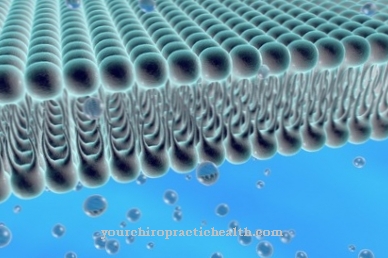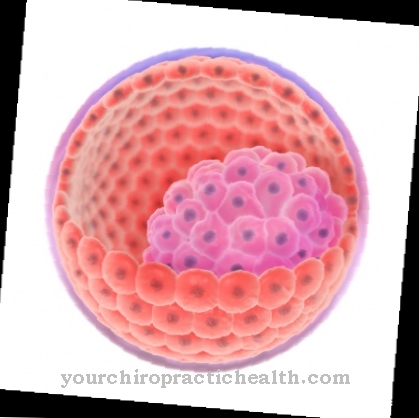In the Apocytosis the membrane of a gland cell is pinched off together with the secretion in a container. It is a secretion mode of apocrine glands, which is a special form of exocytosis and mainly affects the mammary gland. Disorders of the hormonal balance can change the apocytosis behavior.
What is apocytosis?

Gland cells release their secretion in the human body in different ways. In addition to merocrine and holocrine secretion, apocrine secretion is also one of the human types of secretion.
With apocrine secretion, exocytosis takes place, in which vesicles inside a cell fuse with the cell membrane and thus release their secretion. Apocytosis is a special form of these exocytotic processes in apocrine gland cells.
The secretion is constricted together with part of the glandular cell membrane in a container. Thanks to regeneration, this process can take place several times per cell despite membrane losses.
Both exocytosis and apocytosis are therefore secretion modes of glands and gland cells. Exocytosis is rare, especially in the human organism. The most characteristic example is apocytotic fat droplet secretion from the mammary gland. Apart from the mammary gland, the secretion mode in humans is exclusively ascribed to the scent glands and the ciliary glands.
Medicine differentiates between specific and non-specific apocytosis. The unspecific form occurs when matrix vesicles are released with cytosol.
Function & task
Exocytosis is an important mode of secretion of endocrine and exocrine gland cells. It creates secretion vesicles with an average diameter of 50 nm, each of which is surrounded by a double membrane. The gland cell releases the cell contents of the vesicles into the lumen of their duct.
The secretion vesicles are usually formed in the Golgi apparatus of the cells. But they can also pinch off from the endoplasmic reticulum or arise from endocytotic vesicles. In any case, the gland cell transports the vesicles to their cell membrane, with which the vesicle membrane finally fuses.
During the fusion, the cell membrane of the vesicles deviates and the contents of the vesicles are released. This process corresponds to exocytosis, as it is present in numerous endocrine and exocrine gland cells and thus plays a role in the hormonal balance through to thermoregulation through sweating.
Apocytosis is a special form of the processes described, which occurs far less often and primarily fulfills tasks in the nutrition of the offspring. This specifically refers to the specific apocytosis of the mammary gland. The secretory vesicles of the mammary gland cells correspond to fat droplets. Their production is stimulated by the sex hormones and the lactation hormone prolactin. The hormones bind to the receptors of the mammary gland cells and thus initiate apocytosis. Proteins accumulate on the outside of the fat droplets, which bind to the integral proteins of the apical cell membrane. In this way, the fat droplet migrates to the lumen and its attached cell membrane bulges outwards.
On the way to the lumen, the membrane adapts to the shape of the vesicle, rounds off and merges underneath. In this way, the cell membrane constricts together with the cytoplasm and the fat droplets. The secretion is only released from the cytoplasm through the rupture of the surrounding membrane and bladder.
The cell loses volume during secretion because it gives off its own cytoplasm and membrane components with the secretion. Thanks to their ability to regenerate, mammary gland cells are in turn able to perform apocytosis several times despite the loss of volume.
Illnesses & ailments
Scent glands and the mammary gland give off a fatty secretion during apocytosis. Disturbances in the local protective acid mantle can make the areas of these gland cells vulnerable to bacterial infections and lead to abscess formation. The abscesses of the scent glands are often accompanied by fistula formation or inflammatory reactions. The phenomenon is known as acne inversa and mainly affects adolescents in puberty. In the connective tissue of the affected area, flat phlegmons form under the skin, which appear as a bluish discoloration and, depending on their extent, can cause sepsis.
A common disease of the mammary gland is abnormal milk discharge. This phenomenon can occur on one or both sides. Regardless of pregnancy, the glands operate apocytosis and release a milky secretion through the milk ducts. The secreting gland disease is also known as galactorrhea. As a rule, an abnormal hormonal balance is responsible for milk production, which stimulates the glands to apocytosis. Mostly Prolaktion is specially produced. This so-called hyperprolactinemia can be caused, for example, by taking medication or stress. More rarely, benign brain tumors are responsible for the production that release hormones themselves.
The mammary gland itself can also be affected by tumor diseases. This phenomenon also manifests itself under certain circumstances in changed apocytosis behavior, especially in the absence of apocytosis after pregnancy. However, this phenomenon should not be confused with a lack of milk flow after pregnancy. If one or both mammary glands fail to give milk, apocytosis can still occur in the glandular tissue. Usually the cause of the lack of flow is simply a so-called milk blockage. The skin grows over the opening of the milk ducts and the secreted drops build up in the ducts. In addition to the hormonal balance, diet and the psyche also play a role in milk delivery. Therefore, decreased milk flow after pregnancy should not automatically be interpreted as a questionable scenario.













.jpg)

.jpg)
.jpg)











.jpg)